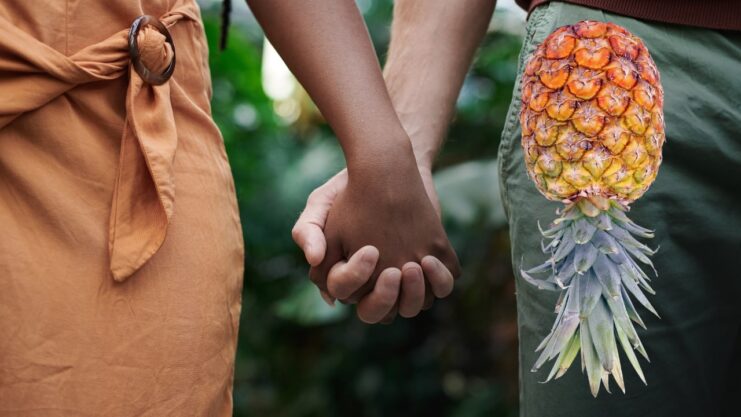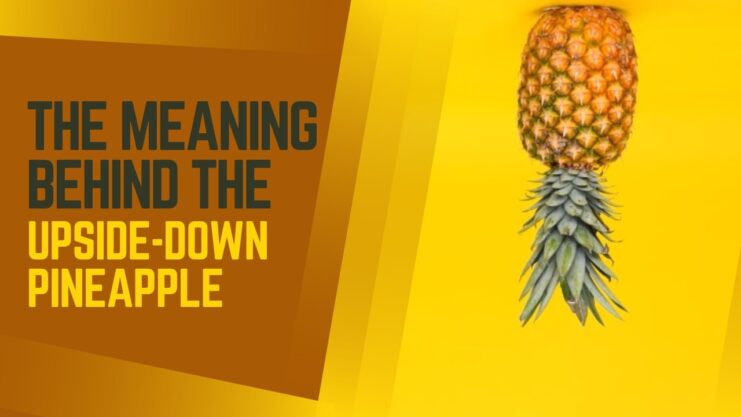The use of everyday objects to communicate secret messages among a select group of individuals is not uncommon. One such object that has held a hidden meaning for many years is the upside-down pineapple. While the symbolism was once a secret, it is now widely known and understood.
So what exactly does an upside-down pineapple signify? Let’s take a closer look to find out.
What Does a Pineapple Symbolize?

The pineapple is a fruit that has held various symbolic meanings throughout history and across different cultures. From hospitality to luxury, the pineapple has become a versatile symbol that represents different concepts depending on its context.
One of the most common symbolic meanings associated with the pineapple is hospitality. In the 18th century, pineapples were an exotic and expensive fruit that only the wealthiest could afford. When a hostess served pineapple to her guests, it signaled that she spared no expense in providing the best for her guests. Today, the pineapple remains a symbol of welcome and warmth, often used in home decor, housewarming gifts, and even on door knockers.
The pineapple has also been associated with luxury and extravagance. Its rare and exotic appearance made it a status symbol in colonial America, and pineapples were often displayed at social gatherings to showcase one’s wealth and good taste. This symbolism has continued into the present day, with pineapple being a popular motif in high-end fashion and home decor.
In addition to hospitality and luxury, the pineapple has held symbolic meanings in different cultures around the world. In Chinese culture, the pineapple is a symbol of wealth and good fortune, while in Hinduism it represents fertility and prosperity. In some African cultures, the pineapple is associated with healing and is used in traditional medicine.
What Does an Upside-Down Pineapple Mean?
An upside-down pineapple has a specific meaning in modern times that may be unfamiliar to some. While traditionally the pineapple has been associated with hospitality and luxury, an upside-down pineapple carries a different connotation altogether.
In recent years, an upside-down pineapple has been used as a symbol to indicate that a person or couple is interested in participating in swinging, a practice that involves couples engaging in sexual activities with other couples. Placing an upside-down pineapple on display, whether it be on clothing or in front of one’s home, has become a subtle way for swingers to identify and communicate with other like-minded individuals.
The origins of the upside-down pineapple symbol are unclear, but it may be connected to the practice of placing a pineapple on one’s front porch as a symbol of welcome and hospitality. According to some sources, turning the pineapple upside-down may have been a way to signify that the welcome was more than just for friends and family, but for anyone who was interested in participating in swinging.
It’s important to note that while the upside-down pineapple has become a symbol for swinging in modern times, not all individuals who display an upside-down pineapple subscribe to this practice. Some may simply enjoy the look of an upside-down pineapple as a decorative element or appreciate its historical association with hospitality.
What Are Swingers?
Swingers are individuals or couples who participate in consensual sexual activities with others outside of their primary relationship. This can include a variety of activities such as partner swapping, threesomes, or group sex. Swingers typically engage in these activities as a way to enhance their sexual experiences and explore their sexuality with others who share similar interests.
The swinging lifestyle has a long history, dating back to the 1950s and 1960s in the United States. However, it has become more widely known and accepted in modern times, with the advent of online dating and social media making it easier for swingers to connect with each other.
Swingers often participate in these activities in private settings such as homes, hotels, or dedicated swinger clubs. It’s important to note that participation in swinging is entirely voluntary and requires the consent of all parties involved. Swingers typically establish rules and boundaries with their partners before engaging in any sexual activities with others.
Is the Swinging Lifestyle Common?
Statistics on the prevalence of swinging are difficult to gather due to the private nature of the activity, but surveys suggest that a small percentage of individuals and couples engage in swinging. A 2017 study conducted in the United States found that around 4% of adults reported having engaged in consensual non-monogamous relationships, which can include swinging.
Despite being a relatively small percentage of the population, swinging has become more visible in popular culture, with references in television shows, movies, and music. The internet has also made it easier for swingers to connect with each other and organize events or meetups.
While the swinging lifestyle may not be as common as other forms of sexual behavior, it is important to recognize and respect the choices and preferences of those who do engage in it. Swinging is a consensual and private activity that should only be pursued with the consent and boundaries of all parties involved.
Other Symbols for Swingers

While the upside-down pineapple has become a well-known symbol for swingers, there are other symbols or indicators that may be used to identify individuals or couples who are interested in swinging. It’s important to note that not all individuals who display these symbols are necessarily swingers, and that the symbols can vary in different regions or communities.
One common symbol for swingers is a black ring worn on the right hand. This symbolizes that the wearer is open to participating in swinging activities, and can be a subtle way to communicate with other swingers without being too obvious.
Another symbol is the use of the term “hotwife” or “hotwifing”. This refers to a married woman who is free to engage in sexual activities with other men, often with the knowledge and consent of her husband. The term “cuckold” may also be used to refer to a man whose wife engages in sexual activities with other men.
Certain clothing items or accessories may also be used as symbols for swingers, such as an anklet worn on the right ankle, a tattoo of a butterfly, or a necklace with a pendant in the shape of the international symbol for swingers – three arrows arranged in a circle.
FAQ
What do Pineapple Tattoos stand for?
Pineapple tattoos have become a popular design in recent years, and they can symbolize a variety of meanings depending on the individual’s interpretation.
One common interpretation is that the pineapple tattoo represents hospitality and welcome. Pineapples were once considered a rare and luxurious fruit, and they were often used as a symbol of wealth and generosity. In this sense, the pineapple tattoo can be a symbol of warmth, friendship, and open-heartedness.
Another interpretation is that the pineapple tattoo represents travel and adventure. Pineapples were first brought to Europe by explorers who discovered them in the Americas, and they have since become a popular symbol of tropical destinations and exotic locations. For some, the pineapple tattoo can represent a love for travel, new experiences, and a sense of wanderlust.
What makes the pineapple famous?
Pineapples are famous for several reasons, including their unique appearance, delicious taste, and cultural significance.
Firstly, pineapples are easily recognizable for their distinctive appearance, with a spiky, textured exterior and a crown of green leaves at the top. This makes them stand out among other fruits and makes them a popular decorative element in many cultures.
Secondly, pineapples are famous for their delicious taste. They are sweet and tangy, with a juicy flesh that’s perfect for snacking or incorporating into recipes. Pineapples are a versatile fruit that can be eaten fresh, canned, dried, or as a juice, making them a popular ingredient in many cuisines around the world.
What is the history of swinging?

The swinging lifestyle has a long and complex history, dating back to the 1950s and 1960s in the United States. During this time, so-called “wife-swapping” parties became popular among suburban couples who were looking to explore their sexuality and break away from traditional gender roles.
The swinging lifestyle continued to evolve throughout the 1970s and 1980s, with the rise of dedicated swinger clubs and publications. These clubs provided a safe and discreet environment for swingers to connect with each other and engage in sexual activities.
In the 1990s and 2000s, the advent of the internet and online dating made it even easier for swingers to connect with each other. Online swinger communities and dating sites provided a platform for couples and individuals to find potential partners and organize events or meetups.
Today, swinging remains a relatively small but visible subculture within the broader world of consensual non-monogamy. Swingers continue to explore their sexuality with like-minded individuals, and the swinging lifestyle continues to evolve and adapt to changing cultural and social norms.
Are there any health risks associated with swinging?
As with any sexual activity, there are potential health risks associated with swinging. These risks can include sexually transmitted infections (STIs), unwanted pregnancies, and emotional or psychological harm.
To minimize these risks, it is important for swingers to practice safe sex by using condoms and getting regular STI testing. Swingers should also establish clear boundaries and communication with their partners to ensure that all parties are comfortable and consenting to the activities.
It is also important for swingers to be aware of their own emotional and psychological well-being, as swinging can be a complex and potentially challenging experience. Seeking the guidance of a therapist or counselor can be helpful in navigating the emotional and psychological aspects of swinging.
Conclusion
In conclusion, the pineapple has a rich history and holds various symbolic meanings across different cultures. While traditionally associated with hospitality and luxury, the upside-down pineapple has become a symbol for swingers in modern times.
Despite being a relatively small percentage of the population, the swinging lifestyle has become more visible in popular culture, with references in media and online communities.
It’s important to respect the choices and preferences of those who engage in swinging, as well as to recognize that not all individuals who display symbols associated with swinging are necessarily interested in participating.
Overall, the pineapple remains a versatile and beloved fruit, appreciated for its unique appearance, delicious taste, and cultural significance.

